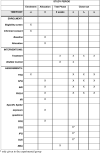Automated app-based augmented reality cognitive behavioral therapy for spider phobia: Study protocol for a randomized controlled trial
- PMID: 35830423
- PMCID: PMC9278761
- DOI: 10.1371/journal.pone.0271175
Automated app-based augmented reality cognitive behavioral therapy for spider phobia: Study protocol for a randomized controlled trial
Abstract
Background: Fear of spiders, or Arachnophobia, is one of the most common specific phobias. The gold standard treatment, in vivo exposure therapy, is effective, but comes with significant limitations, including restricted availability, high costs, and high refusal rates. Novel technologies, such as augmented reality, may help to overcome these limitations and make Exposure Therapy more accessible by using mobile devices.
Objective: This study will use a Randomized Controlled Trial design to investigate whether ZeroPhobia: Arachnophobia, a 6-week Augmented Reality Exposure Therapy smartphone self-help application, can effectively reduce spider phobia symptoms. Additionally, we will examine user-friendliness of the application and the effect of usage intensity and presence on treatment outcome.
Methods: This study is registered in the Netherlands Trial Registry under NL70238.029.19 (Trial NL9221). Ethical approval was received on October 11, 2019. One-hundred-twelve participants (age 18-64, score ≥ 59) on the Fear of Spiders Questionnaire [FSQ] will be recruited from the general Dutch population and randomly assigned to a treatment or waitlist control group. The ZeroPhobia application can be accessed on users' smartphone. Baseline, post-test (i.e., at six weeks), 3- and 12-month follow-up assessments will be done, each including the Fear of Spiders Questionnaire as the main outcome measure as well as additional measures of anxiety, depression, user-friendliness, and presence as secondary measures and covariates.
Results: The study was funded on September 25, 2018. Data collection started in September 2021 and the study is expected to run until September 2022.
Conclusions: Our study will improve our understanding of the efficacy and feasibility of providing Exposure Therapy for spider phobia using an Augmented Reality self-help application, with the intention of making mental health care more accessible.
Conflict of interest statement
I have read the journal’s policy and the authors of this manuscript have the following competing interests: TD and JLvG have developed the ZeroPhobia application, which is used in the present study in collaboration with Vrije Universiteit. ZeroPhobia is intended for commercial release. Hence, TD and JLvG will not be involved in data analysis or with any decisions related to the publication of findings. This does not alter our adherence to PLOS ONE policies on sharing data and materials. The other authors have declared that no competing interests exist.
Figures






Similar articles
-
Virtual Reality Self-help Treatment for Aviophobia: Protocol for a Randomized Controlled Trial.JMIR Res Protoc. 2021 Apr 12;10(4):e22008. doi: 10.2196/22008. JMIR Res Protoc. 2021. PMID: 33843605 Free PMC article.
-
Effectiveness of a smartphone-based, augmented reality exposure app to reduce fear of spiders in real-life: A randomized controlled trial.J Anxiety Disord. 2021 Aug;82:102442. doi: 10.1016/j.janxdis.2021.102442. Epub 2021 Jul 2. J Anxiety Disord. 2021. PMID: 34246153 Clinical Trial.
-
Single-session gamified virtual reality exposure therapy for spider phobia vs. traditional exposure therapy: study protocol for a randomized controlled non-inferiority trial.Trials. 2016 Feb 2;17:60. doi: 10.1186/s13063-016-1171-1. Trials. 2016. PMID: 26833396 Free PMC article. Clinical Trial.
-
Virtual Reality, Augmented Reality, and In Vivo Exposure Therapy: A Preliminary Comparison of Treatment Efficacy in Small Animal Phobia.Cyberpsychol Behav Soc Netw. 2019 Jan;22(1):31-38. doi: 10.1089/cyber.2017.0672. Epub 2018 Oct 18. Cyberpsychol Behav Soc Netw. 2019. PMID: 30335525 Free PMC article. Review.
-
Spider Phobia: Neural Networks Informing Diagnosis and (Virtual/Augmented Reality-Based) Cognitive Behavioral Psychotherapy-A Narrative Review.Front Psychiatry. 2021 Aug 24;12:704174. doi: 10.3389/fpsyt.2021.704174. eCollection 2021. Front Psychiatry. 2021. PMID: 34504447 Free PMC article. Review.
Cited by
-
The Efficacy and Therapeutic Alliance of Augmented Reality Exposure Therapy in Treating Adults With Phobic Disorders: Systematic Review.JMIR Ment Health. 2023 Nov 30;10:e51318. doi: 10.2196/51318. JMIR Ment Health. 2023. PMID: 38032710 Free PMC article. Review.
-
Extended Reality for Mental Health Evaluation: Scoping Review.JMIR Serious Games. 2024 Jul 24;12:e38413. doi: 10.2196/38413. JMIR Serious Games. 2024. PMID: 39047289 Free PMC article.
References
-
- American Psychiatric Association. Diagnostic and statistical manual of mental Disorders. 5th ed. Arlington, VA: American Psychiatric Publishing; 2013.
-
- Nathan PE, Gorman JM. A guide to treatments that work. NewYork: Oxford University Press; 2007.
Publication types
MeSH terms
Supplementary concepts
LinkOut - more resources
Full Text Sources
Medical

